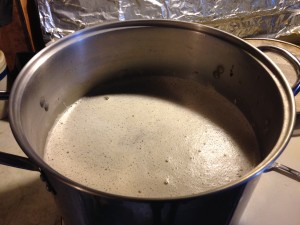This is the continuation of a previous post.
 The lower temperature rests in a step mash deal with hydration, mash pH, proteins, and beta glucans. They are not needed with most fully-modified malts, but work well with undermodified malts or home malted barley. Two of the three remaining rests deal with the degradation of carbohydrates — how starch is broken down into a mixture of fermentable sugars and unfermentable carbohydrates. These rests can be performed regardless of the type of malt you are mashing.
The lower temperature rests in a step mash deal with hydration, mash pH, proteins, and beta glucans. They are not needed with most fully-modified malts, but work well with undermodified malts or home malted barley. Two of the three remaining rests deal with the degradation of carbohydrates — how starch is broken down into a mixture of fermentable sugars and unfermentable carbohydrates. These rests can be performed regardless of the type of malt you are mashing.
Beta-amylase Rest (140–147 °F/60–64 °C)
If you are looking to brew a dry beer, a rest in this range — in which beta-amylase is at it’s optimum — will help. A rest in this range produces a more highly-fermentable wort, with more of the short-chained carbohydrates (“dextrins”) reduced to fermentable sugars. Even if you are using fully-modified malt, you can rest in this range without negative consequences. (The protein-degrading enzymes may not be completely denatured yet, but resting here is not known to cause problems with foam.)
For a beer that is slightly drier than one made from a single infusion mash, try a 15-minute rest at around 145 °F (63 °C), right near the optimum for beta-amylase, then bump the temperature up to 152–154 °F (67–68 °C) and rest for a further 45 minutes to 1 hour.
For a very dry beer, try resting at 140–142 °F (60–61 °C) for 30 minutes to 2 hours before finishing the mash at a higher temperature. If you’re trying to make a dry beer, stirring the mash a few times will ensure it is mixed well and bring the enzymes and substrate into contact faster. (Especially in thick mashes, enzymes can get surrounded by their product, limiting their ability to bump into more substrate.)
Barley starch from malted barley typically gelatinizes in the 138–145 °F (59–63 °C) range, but rests in the 140–145 °F (60–63 °C) range are still very effective even if the starch hasn’t fully gelatinized. At a minimum, amylase enzymes can act at on starch at the outside of the granules.
Saccharification Rest (148–162 °F/64–72 °C)
This is the range for a single infusion mash. In a step mash, you can think of it as the finishing rest. At these temperatures, any remaining un-gelatinized starch will be fully-gelatinized and the amylase enzymes can complete starch conversion. If you’ve rested in the (140–147 °F/60–64 °C) range, especially when brewing with malt with a high diastatic power, you may only need a short rest to finish things up. At short as 5 minutes might do the trick. (Use the iodine test to be sure.)
If you are using undermodified malt or home malted barley, and your previous rest was in the beta-glucase range, you may need to rest here for almost as long as regular single infusion mash.
Step mashes can be time-consuming, especially when the mash is being heated and the ramp times between rests are fairly long. Using an iodine test to confirm complete starch conversion can let you know as soon as it is OK to proceed to the mash out. Factors contributing to a shorter required rest in this range include the use of high-enzyme malt (malt with a high diastatic power), a rest in the beta amylase range, and the longer times spent at lower-temperature rests.
Mash Out (168–170 °F/76–77 °C)
The reasons to perform a mash out are exactly the same as when considering a mash out in a single infusion mash. Given that step mashes can take a long time, some homebrewers skip this step. If you do, it is unlikely your beer will suffer.
General Thoughts
Step mashes tend to produce beers on the dry side, especially when higher diastatic power malts are used. (With undermodified malts, the effect may be less pronounced.) A beer made with a step mash ending at 153 °F (67 °C) is going to be more dry than a beer made with a single infusion mash at 153 °F (67 °C). This is mostly due to the amylase enzymes being active (albeit at lower activity levels) at the lower temperature rests and the longer overall time the enzymes have to work on the carbohydrates in the mash.
If you want to brew a sweeter, more full-bodied beer, your best bet is a single infusion mash. Or, use a base malt without a lot of diastatic power, and keep the rests in a step mash — and the amount of time it takes to boost the temperature between them — as short as possible.
—
Related articles
Choosing a Mash Method (Single Infusion Mashes)

Are the temperatures in the second paragraph of the Beta-amylase Rest section correct? Shouldn’t the 155 step be 145?
The rest should be at 145 °F (63 °C). There was a typo in the Fahrenheit temperature. Fixed. Thanks.
The low end of the Beta-amylase range will also put you within the range of Limit Dextrinase, which will help to dry your beer out even further.